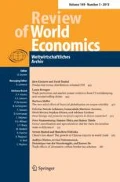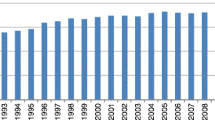Abstract
This paper presents a dynamic model of risk-averse producers’ decision to invest in physical capital and to export. The model features irreversible investment, no capital markets and fixed and sunk costs to export. Several features of the distribution of investment rates and export participation patterns observed in firm-level data are closely matched in a calibration exercise. Counterfactual experiments show that large adjustments in total sales associated with entry into foreign markets increase the volatility of total sales for exporting firms.







Similar content being viewed by others
Notes
Although the information in this data set is available at the plant level, I will use the term “firm” to maintain consistency throughout the paper.
These costs include setting up a distribution network abroad, adjusting product characteristics to comply with foreign regulations, gathering market-specific information, etc.
Installation disruptions, capital indivisibilities, retraining and restructuring costs, transaction costs, etc.
Maloney and Azevedo (1995) note that in developing countries it is common for firm managers to own large shares of the firms they run. Even in a developed economy like the United States, Moskowitz and Vissing-Jørgensen (2002) find that around 75% of all private equity is owned by households for whom it constitutes at least half of their total net worth.
I am grateful to an anonymous referee for suggesting the inclusion of this experiment.
However, neither of these papers addresses the substantial degree of lumpiness and high frequency of inaction observed in plant-level investment.
Early theoretical contributions by Clark (1973), Eldor and Zilcha (1987), Donnenfeld and Zilcha (1991) among others, study the export supply decision of a risk-averse monopolist and perfectly competitive firms, and how this decision is influenced by exchange rate volatility. These studies did not consider firm heterogeneity or entry and participation costs to start exporting. On the empirical side, Hirsch and Lev (1971), using a small sample of firms in Denmark, Israel and the Netherlands, find that international diversification is positively correlated with total sales stability.
At the three-digit industry level di Giovanni and Levchenko (2009) find that sectors that are more open to international trade are more volatile.
The model abstracts from entry and exit into and out of the domestic market.
Alternatively, one could assume a technology that uses both capital and labor, where labor is a fully flexible input. The main results of the model remain unchanged.
Thus, investment at t completely determines the production possibilities of the firm at t + 1. This contrasts with the model of Cooley and Quadrini (2001) where there is a market in which firms can rent capital to/from other firms.
In other words, the decision to export would be irreversible.
Roberts and Tybout (1997) find evidence of non-zero entry costs into foreign markets for manufacturing plants in Colombia. They also find that plants that have not operated in the export market for 2 years or more face re-entry costs that are not significantly different from the entry costs faced by plants that have not exported before. This is why I assume that a firm that stops exporting has to pay the sunk entry cost whenever it decides to start exporting again, regardless of its previous exporting experience. This assumption greatly simplifies the solution of the dynamic problem of the firm.
Gelos and Isgut (2001) use a similar depreciation rate of 7% for machinery and equipment in their study of Colombian and Mexican manufacturing plants.
Another way to compare the relative size of the entry and continuation costs of exporting is simply to look at the ratio of the calibrated/estimated parameters that different authors report. Alessandria and Choi (2007) find a ratio of 4.8 and Ruhl and Willis (2008), 9.2. Das et al. (2007) estimates for the continuation costs are not statistically different from zero.
In a Melitz-type model, calibrating the entry and continuation costs of exporting in order to match the share of exporting firms alone would result on mean export-sales ratios that are too high relative to the data. Similarly, matching the mean export-sales ratio would necessitate relatively low fixed and sunk costs, thus producing too many exporting firms.
I calculate sales volatility using a 10-years rolling window as follows: \(\hbox{sd}(r_t) = \left(\frac{1}{10}\sum_{\tau=t-4}^{t+5}(r_{\tau}-\overline{r_t})^2\right)^{1/2},\) where r t denotes total sales at time t.
Firms starting to export are on average 33.7% larger in terms of capital stock relative to five periods before exporting.
New exporters are 24% larger than exiting exporters, and these firms are twice as big as domestic firms in terms of their sales in the Colombian data.
To make the second experiment comparable with the benchmark, I adjust the mean of the foreign demand shock downwards to make sure that the mean export-sales ratio is the same in both scenarios.
References
Alessandria, G., & Choi, H. (2007). Do sunk costs of exporting matter for net export dynamics? Quarterly Journal of Economics, 122(1), 289–336.
Armenter, R., & Koren, M. (2009). Economies of scale and the size of exporters. (Research Department Working Paper 15). Philadelphia, PA: Federal Reserve Bank.
Baldwin, R., & Krugman, P. (1989). Persistent trade effects of large exchange rate shocks. Quarterly Journal of Economics, 104(4), 635–654.
Bernard, A. B., & Jensen, J. B. (1999). Exceptional exporter performance: Cause, effect, or both? Journal of International Economics, 47(1), 1–25.
Bernard, A. B., Jensen, J. B., Redding, S. J., & Schott, P. K. (2007a). Firms in international trade. Journal of Economic Perspectives, 21(3), 105–130.
Bernard, A. B., Redding, S. J., & Schott, P. K. (2007b). Comparative advantage and heterogeneous firms. Review of Economic Studies, 74(1), 31–66.
Bond, E., Tybout, J. R., & Utar, H. (2008). Credit rationing, risk aversion, and industrial evolution in developing countries. (NBER Working Paper 14116). Cambridge, MA: National Bureau of Economic Research.
Broda, C., & Weinstein, D. E. (2006). Globalization and the gains from variety. Quarterly Journal of Economics, 121(2), 541–585.
Buch, C., Doepke, J., & Strotmann, H. (2009). Does export openness increase firm-level volatility? The World Economy, 32(4), 531–551.
Caballero, R. J. (1991). On the sign of the investment-uncertainty relationship. American Economic Review, 81(1), 279–288.
Caballero, R. J. (1993). On the dynamics of aggregate investment. In: L. Serven & A. Solimano (Eds.), Striving for growth after adjustment—The role of capital formation. Washington, DC: World Bank.
Caballero, R. J. (1999). Aggregate investment. In J. Taylor & M. Woodford (Eds.), Handbook of macroeconomics. Amsterdam: North-Holland.
Clark, P. B. (1973). Uncertainty in the exchange rate and the level of international trade. Western Economic Journal, 11(3), 302–313.
Comin, D., & Philippon, T. (2006). The rise in firm-level volatility: Causes and consequences. NBER macroeconomics annual, 20, 167–201.
Cooley, T., & Quadrini, V. (2001). Financial markets and firm dynamics. American Economic Review, 91(5), 1286–1310.
Cooper, R. W., & Haltiwanger, J. C. (2006). On the nature of capital adjustment costs. Review of Economic Studies, 73(3), 611–633.
Das, S., Roberts, M. J., & Tybout, J. R. (2007). Market entry costs, producer heterogeneity and export dynamics. Econometrica, 75(3), 837–873.
di Giovanni, J., & Levchenko, A. (2009). Trade openness and volatility. Review of Economics and Statistics, 91(3), 558–585.
Doms, M., & Dunne, T. (1998). Capital adjustment patterns in manufacturing plants. Review of Economic Dynamics, 1(2), 409–429.
Donnenfeld, S., & Zilcha, I. (1991). Pricing of exports and exchange rate uncertainty. International Economic Review, 32(4), 1009–1022.
Eaton, J., Eslava, M., Kugler, M., & Tybout, J. R. (2008). The margins of entry into export markets: Evidence from Colombia. In D. Marin & T. Verdier (Eds.), The organization of firms in the global economy. Cambridge, MA: Harvard University Press.
Eldor, R., & Zilcha, I. (1987). Discriminating monopoly, forward markets and international trade. International Economic Review, 28(2), 459–468.
Gelos, G., & Isgut, A. (2001). Fixed capital adjustment: Is Latin America different? Review of Economics and Statistics, 83(4), 717–726.
Hirsch, S., & Lev, B. (1971). Sales stabilization through export diversification. Review of Economics and Statistics, 53(3), 270–277.
Iacovone, L., & Javorcik, B. S. (2009). Shipping the good tequila out? Investment, domestic unit values and entry of multi-product plants into export markets. Manuscript, University of Oxford.
Khan, A., & Thomas, J. K. (2008). Idiosyncratic shocks and the role of nonconvexities in plant and aggregate investment dynamics. Econometrica, 76(2), 395–436.
Lawless, M. (2010). Geography and firm exports: New evidence on the nature of sunk costs. Review of World Economics/Weltwirtschaftliches Archiv, 146(4), 691–707.
Maloney, W. F., & Azevedo, R. R. (1995). Trade reform, uncertainty and export promotion: Mexico 1982–1988. Journal of Development Economics, 48(1), 67–89.
Moskowitz, T., & Vissing-Jørgensen, A. (2002). The returns to entrepreneurial investment: A private equity premium puzzle? American Economic Review, 92(4), 745–778.
Riaño, A. (2010). The decision to export and the volatility of sales. (Working Paper 2010/12). Nottingham: Leverhulme Centre for Research in Globalisation and Economic Policy.
Roberts, M. J., & Tybout, J. R. (1996). Industrial evolution in developing countries: Micro patterns of turnover, productivity and market structure. New York, NY: Oxford University Press.
Roberts, M. J., & Tybout, J. R. (1997). The decision to export in Colombia: An empirical model of entry with sunk costs. American Economic Review, 87(4), 545–564.
Ruhl, K. J., & Willis, J. L. (2008). New exporter dynamics. Manuscript, New York University.
Suwantaradon, R. (2008). Financial frictions and international trade. Manuscript, University of Minnesota.
Tauchen, G. (1986). Finite state markov-chain approximations to univariate and vector autoregressions. Economics Letters, 20(2), 177–181.
Vannoorenberghe, G. (2010). Firm-level volatility and exports. Manuscript, Tilburg University.
Veracierto, M. L. (2002). Plant level irreversible investment and equilibrium business cycles. American Economic Review, 92(1), 181–197.
Vogel, A., & Wagner, J. (2010). Higher productivity in importing german manufacturing firms: Self-selection, learning from importing, or both? Review of World Economics/Weltwirtschaftliches Archiv, 145(4), 641–665.
Acknowledgments
I would like to thank Jim Tybout, Eugenia Gonzalez, Andreas Hoefele, Andrés Rodríguez-Clare, Erdal Yalcin, Ruilin Zhou, two anonymous referees and participants at ETSG 2010, the Ifo/GEP Conference on Products, Markets and Export Dynamics and the Spring 2010 Midwest International Trade Meetings for useful comments. Financial support from COLFUTURO is gratefully acknowledged.
Author information
Authors and Affiliations
Corresponding author
About this article
Cite this article
Riaño, A. Exports, investment and firm-level sales volatility. Rev World Econ 147, 643–663 (2011). https://doi.org/10.1007/s10290-011-0104-z
Published:
Issue Date:
DOI: https://doi.org/10.1007/s10290-011-0104-z



